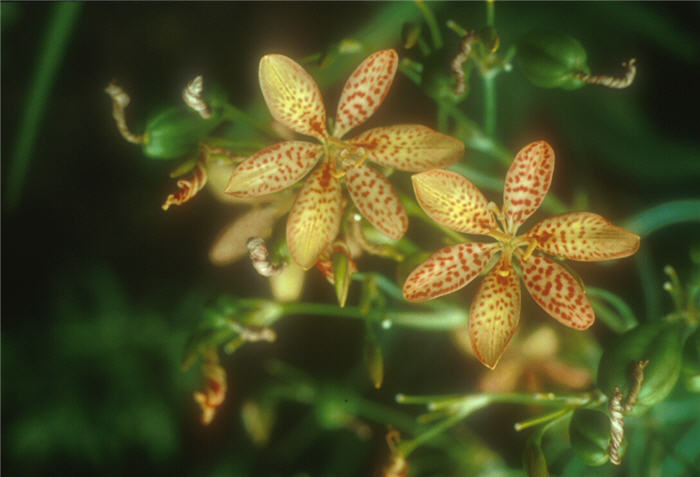| Botanical Name: Belamcanda chinensis | |
| Common Name: Blackberry Lily |

-
Anatomy
-
Culture
-
Design
Plant Type
Perennial, Annual
Height Range
1-3'
Flower Color
Orange, Red
Flower Season
Summer
Leaf Color
Green
Bark Color
n/a
Fruit Color
n/a
Fruit Season
n/a
Sun
Full, Half
Water
Medium
Growth Rate
Moderate
Soil Type
Sandy, Clay, Loam, Rocky, Unparticular
Soil Condition
Average, Rich, Well-drained, Moist
Soil pH
Neutral
Adverse Factors
n/a
Design Styles
English Cottage, Tropical
Accenting Features
n/a
Seasonal Interest
Summer
Location Uses
Perennial Border, Patio
Special Uses
Container, Cut Flowers, Small Spaces
Attracts Wildlife
n/a
Information by: Stephanie Duer
Photographer: JJ Neilson Arboretum
Photographer: JJ Neilson Arboretum
-
Description
-
Notes
Blackberry lily (also commonly called leopard lily) is an erect, rhizomatous perennial which typically grows 2 to 3 feet tall, and a foot or two wide. Lily-like, deep orange flowers, heavily spotted with red dots, appear in early to-mid summer in sprays above the foliage on wiry, naked stems. Sword-shaped, iris-like, medium green leaves are in flattened fans. Flowers give way to pear-shaped seed pods which split open when ripe (late summer), with each pod revealing a blackberry-like seed cluster, hence the common name of blackberry lily. Spotting on the flowers gives rise to the additional common name of leopard lily. Also listed as Iris domestica.
Grow in average, medium, well-drained soils in full sun. Likes moist soils, but poorly-drained ones, particularly in winter, can be fatal. Clumps slowly expand by creeping rhizomes. May self-seed in optimum growing conditions which helps keep these somewhat short-lived perennials in the garden. In all honesty, it is difficult to get these to over-winter, though I know of a few gardens where they flourish. You can buy them as plants or bulbs, and the plants might be a safer bet as at least you'll get flowers that summer. As a result, am hesitant to list them as perennial.